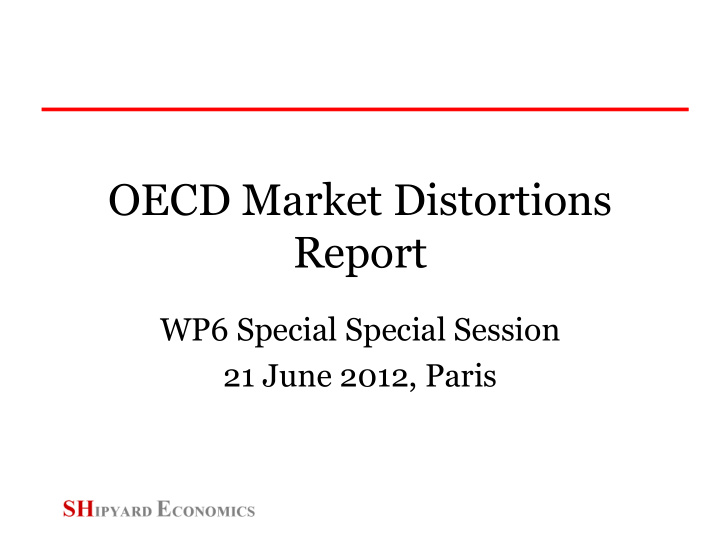



OECD Market Distortions Report WP6 Special Special Session 21 June 2012, Paris
Objectives of Study • Assess and identify the existence of market distorting practices OR • Identify characteristics of global shipbuilding which would prevent such distortion
Key Issues • What is the yardstick against which fair practice is determined? • What are the characteristics of shipbuilding that market regulation has to address? • What is workable? • How does the process of addressing this affect or influence matters
Trade Regulation • Two main categories of categories – International trade (through WTO) driven by anti- dumping (AD) treatments – National anti-trust (AT) policies • International dispute process is very lengthy & cumbersome based on the subsidy examples in shipbuilding & aerospace • National AT policies vary considerably • 1994 Agreement was a ‘special’ agreement based on AD which recognised certain practical issues – Customs status & remedy practicalities – Comparative transaction concept
1994 Agreement • Revolved around Injurious Pricing and WTO Anti- dumping approach • Was never brought in to force & would not be workable • Geographic distribution of shipbuilding changes & any new agreement would need ‘future proofing’ • Current leading shipbuilding nation, China, and other emerging shipbuilding countries are not OECD members • Little or no prospect of gaining consensus to any new agreement that was based on previous agreement
Shipbuilding Market • Geographical Segmentation X • Product Type Segmentation X • Integrated Global Market √ In a global market arguably export and domestic markets are one and the same
Shipbuilding Characteristics • Do not support a ‘like product’ approach • Substantially involve estimated costs and risk pricing • Complaints or investigations cannot take place at the point of contracting, and hence not processed in a timely manner • There is a substantial delay between contracting and realisation of actual costs that would be problematic in market regulation • Raise queries over an agreed and realistic basis of product / project costing
Product / Project Costing • There is no consensus amongst the main shipbuilding countries over what is a fair pricing basis. • Views indicate it lies somewhere between: – Variable costs – Full recovery (or full absorption) costing • In value terms these two extremes represent wildly different values for vessel costs • Injurious pricing & 1994 Agreement presumed full recovery costing PLUS profit margin
Market Pricing Shipbuilding Prices Index - Long Term Trends - End Period 240 220 200 Index: 1980 = 100 180 160 140 120 100 80 60 1990 1993 1996 1999 2002 2005 2008 2011 Bulk Carrier Container Ship Oil Tankers LPG LNG Chemical Tanker Newbuilding Index • 1990s – output growing prices declining • 2002 – 2008 output growing prices rising • 2009 – 11 output growing prices declining • Differing trends between ship types
Price vs Cost Trends Ship Prices vs Steel & Metal Prices Steel prices US$/t Metals Price Index Newbuilding Index 1100 240 220 1000 200 900 180 800 US$ per tonne 160 700 Index 140 600 120 500 100 400 80 300 60 200 40 1995 1996 1997 1998 1999 2000 2001 2002 2003 2004 2005 2006 2007 2008 2009 2010 2011 2012
Full-Recovery Costing • Inconsistent with market pricing driven by the customer market • Would result in ship prices rising at periods of low demand which is counter-intuitive • Shipbuilding prices are based on estimates & risk pricing • Time delay between contracting and production means that production volumes (as well as production costs) are unknown at contracting
Variable Contribution Pricing • Market pricing means that contribution levels are determined by shipping market • Perceived need for periodic ‘under pricing’ • Allows cross-subsidy between ship types to take into account the variations in demand between different ship types • Long term trends for shipbuilding show periods of sustained loss-making with barriers to exit and limited options for diversification
Issues for Shipbuilding • Agreed basis of ‘Fair Pricing’ • Cyclicality – Shipbuilding Prices – Shipbuilding Production at Ship Type level • Overcapacity • Rapid emergence of new capacity • Shipping market influences • Abuse of regulation process • Vertical integration with supplier & customer markets causes a pincer effect
Specific Issues • Injurious Pricing • Price Collusion • Dominance and Abuse of Position – Two largest shipbuilders accounted for 13% (Hyundai Group) and 12% (State owned CSSC + CSIC) • Predatory Actions • Cartel Behaviour • Cross – subsidy within Supply Chain – Why is this different for Shipbuilding
Non-Price issues • Market Access – a few examples of issues in localised markets – USA – Jones Act – Brazil – Local content requirement – India – preferential taxation for domestic ships built in Indian yards • Relationship to subsidy control in certain economies • Centre of gravity of many international maritime organisations lies in the West whereas nowadays shipbuilding lies predominantly in the East
Process Issues • Points of Agreement – Global market – Concern over abuse of process – Periodic ‘under pricing’ but not on time limits – Dislike of pricing mechanism by customers • Points of Diversity – Need for pricing mechanism – Basis of fair pricing – Integrated product market? • Mechanics of Representation – Government approach brings in other issues – If market is global why is nationality relevant
Way Forward • Consensus – Clean start – Future proofing – Industry focused – Interest categories - market leaders, minority players, new entrants and declining economies • Common Ground • Simple Principles • Non - Starters • Self Regulation
Recommend
More recommend